Wir sind mit dem Zug von Windhoek nach Swakopmund gefahren. Eine Namibianerin hat uns erstaunt angeschaut: Mit dem Zug? Hier faehrt keiner mit dem Zug!
Tja, so ist es auch. Eine richtige Bummelbahn. Und ein richtiges Erlebnis. Es ist eine Schmahlspurbahn. Eine olle Diesellok, zwei Container-Wagongs, ein Personen-Wagon, ein leerer Wagon und ein weiterer Container-Wagon in dem unsere Raeder waren. Dieser lustige Spielzeugzug fuhr dann ihm wahnwitzig langsamen Tempo durch die Nacht: Fuer 300 Kilometer braucht er 10 Stunden.




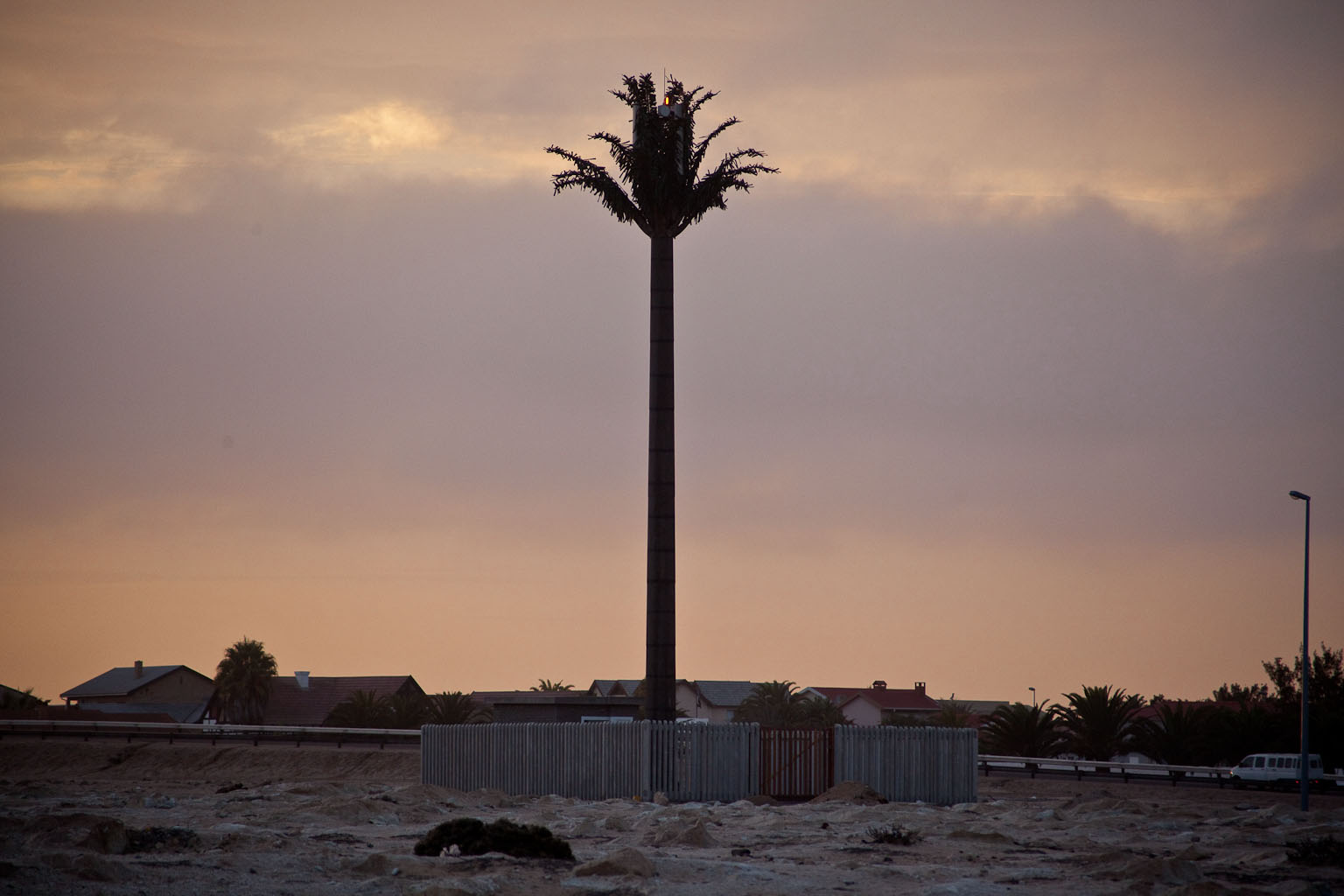

Am morgen fahren wir dann die Skaleton Coast nach Norden. Nach unserem Reisefueher hoert es sich eigentlich Spannend an. Es war dann aber eher oed. Einfach ein sehr sehr weiter Strand ohne alles.
Da es weiter im Norden zu massiven Ueberschwemmungen, unterspuelten Pisten und keiner Lebensmittel-Versorgung gegeben ist, sind wir nach einem Rad-Tag von der Kueste ins Landesinnere abgebogen. Die Landschaft ist anfangs sehr Islaendisch (Vulkan-Wuesten-artig mit zugezogenem Himmel, alles grau) wird dann innerhalb von einem Tag zum Afrika-Paradies. Langsam, ganz langsam (in Radgeschwindigkeit gemessen) erkennt man erst ein leichtes gruen im Schatten von Fussballgrossen steinen. Es komen erste Duenen, in deren Windschatten man leichten gruenen Moos erkennen kann. Dann erste Graeser und Springboeke am Horizont.
Die Landschaft schiebt sich weiter zusammen: Huegel, am Horizont taucht der Brandberg auf, ueber ihm tronen die tropischen Nachmittags Gewitter Wolken.
Und dann steht kniehohes Gras, die in der Nachmittagssonne golden leuchten. An den Wasserlaeufen wachsen Savannen-Baeume.
Nachdem wir kostenlos in einer Lodge Campen duerfen, investieren wir das Geld in Wild-Geschnaetzeltes in Kaesesahnesosse an Spagetti.
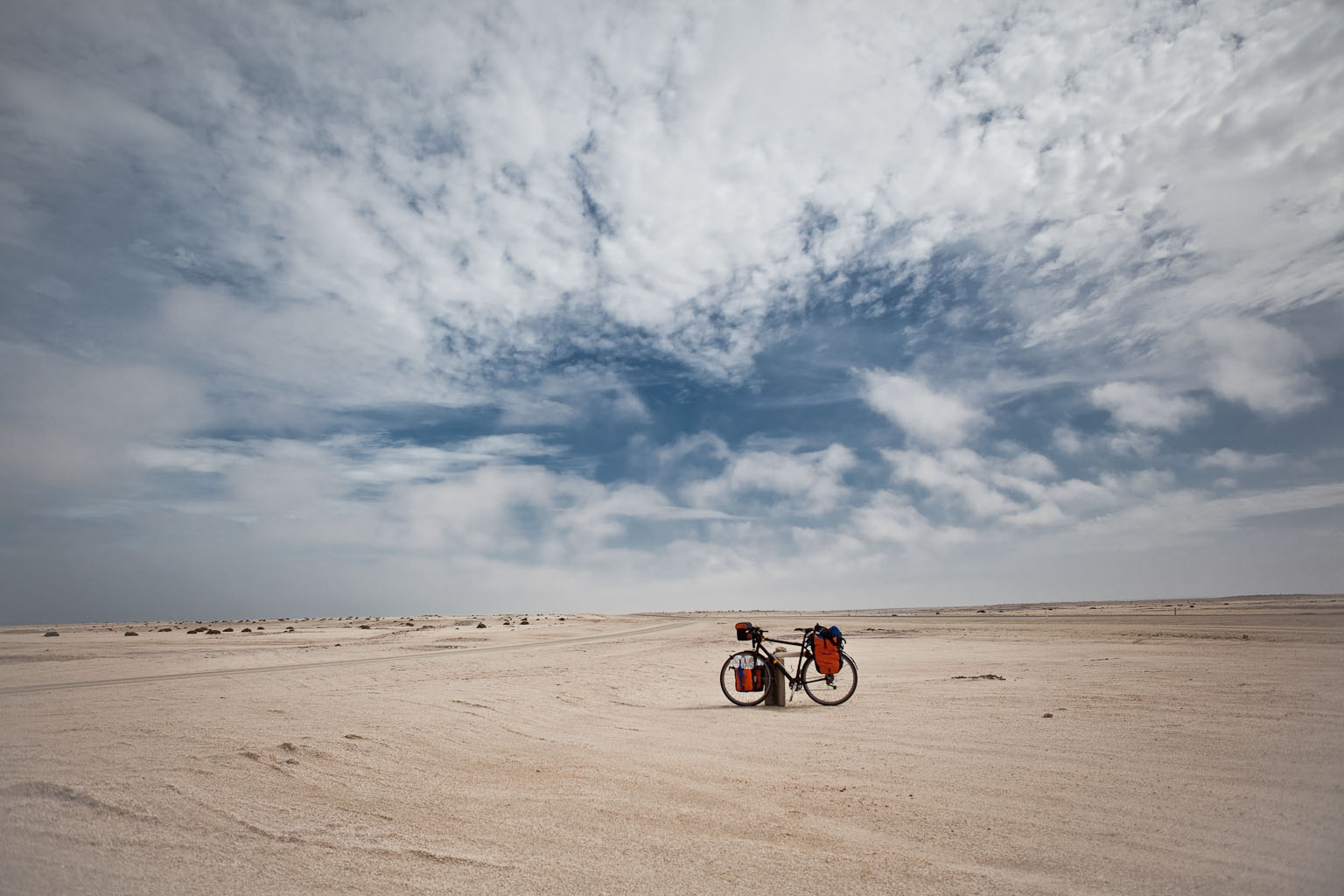
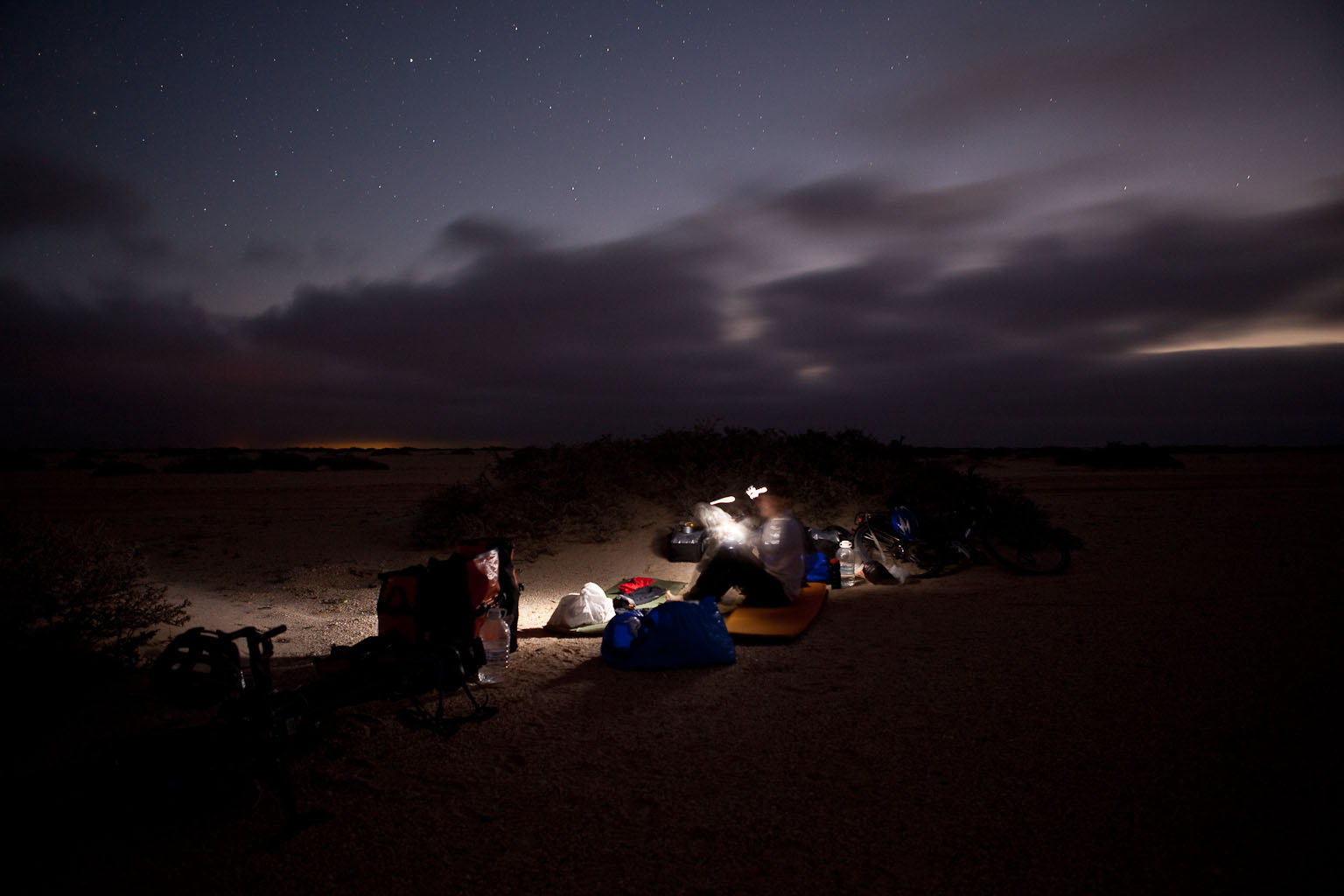
Die Landschaft entwickelt sich in den naesten Tagen immer weiter. Verwunschene Felsvormationen, Taeler, Blumen, ein wasserfuehrender Fluss.
Am Nachmittag kuendigt sich ein Gewitter an. Wir fahren weiter. Mit dem Wissen, dass es keinen Camping oder Lodge geben wird. Wir sind mitlerweile in Elephantengebiet. Das viele Wasser fuehrt sie aber in Gegenden weit von Menschen enfernt. Eigentlich schade, erlaubt es wohl aber doch wildes Campen (im Caprevi werden wir sie dann wohl zu sehen bekommen)
Der Himmel zieht dich im Laufe des Nachmittags immer weiter zu. Von allen Seiten. Blitze zucken am Horrizont, man sieht Starkregengebiete. Wir verpacken alles Wasserdicht, hohlen Regenjakcken raus. Doch genau ueber uns regnet es nicht. Selbst wenn wir auf regennasser Piste fahren. Dann kurz vor Sonnenuntergang erreicht uns die Gewitterfront von allen Seiten mit Platzregen. Hinter uns faerbt sich der Himmel knall Rot, waehrend wir in eine diefe dunkelheit fahren. Blitze erlaeuchten immer wieder den Himmel. Die Piste steht komplett unter Wasser. An einer Kreuzung soll sich eine Wildlife-Station befinden. Wie weit wird es sein?! Der Busch um uns herrum steht Knoecheltief unter Wasser.
Unter der Regensicheren Veranda der vom WWF unterstuetzten Station bauen wir das Moskito Netz auf.

It’s been a time (or at least it appears to us to have been a while) since the last report and of course there’s a lot to tell you again. So just keep on reading.
As said (and that’s pretty much the only thing about our last plan that survived) we took the train to Swakopmund the evening we posted the last text. The ride was.. well interesting. A Tokio-Action-B-Movie running on onboard tv, the train except for us, one drunk and three sober Namibians empty, 1 passenger compartement, three for cargo (one of them carrying our bikes). The train crept through the desert at 7mph and we arrived at Swakop at 6a.m. We spent two hours waiting for the depot to open and then.. finally! We were on the road again.
The road out of Swakop north takes you up the famous Skelleton Coast National Park. Our Lonely Planet Guide was so enthusiastic about it we were imagening the most fantastic coastal beauty there could ever be. Not.
The Skelleton Coast up to Hentis’ Bay has greatest potential to be the most boring place on earth. Okay, that’s perhaps a little exaggerated (I hear the midwest is said to be real bad) but there’s literally nothing. It’s permanently gray. The sky is gray and grizzly, the ocean is gray, the rough sand is gray, the horizon is gray, the people are gray (or appear to be gray), the houses are gray. That’s about it. It’s vast and open and – you can’t say it often enough – gray.
It does have a certain beauty to it but it quintessence it’s just boring. It was the first time since Germany I started listening to music while cycling.

Anyway once we arrived in Hentis’ Bay we had decided not to proceed on our former plan up the Coast for another 300km. At the tourist information they had also told us that the road up there was totally destroyed by heavy rainfalls and the rivers too flooded for cyclists to cross (we later discovered that we’re better at crossing rivers then 4×4 cars). So we turned to Uis, 50 km onwards into the desert and things kept slowly changing.
First you would get a hint of green in the shade of a dune, then you would see a patch of grass in the shade of a larger dune and eventually without a real border the desert changed into an endless and lush grassland. The grass has those silverish tops that will reflect the light of the setting sun and then the whole land, 20km of rolling hills will gleam in a silverish golden light. It’s just amazing. The country is spotted with small rockformations and bushes, in the distance you will have Springboks grazing. You could just stare there, gazing at the scenery for days probably.
That is if you weren’t a cyclist who has been going on gravel roads for 80km now and is scenting a steak only 10km ahead. That’s what we got then, a steak and free camping in honour of our effort at the great Brandfontein Rest Camp in Uis. The owner was an amazing person. This only ment positively: He looked like a mixture of a pirate and Indiana Jones. The one stereotype look you would imagine if asked to picture a white bush adventurer.
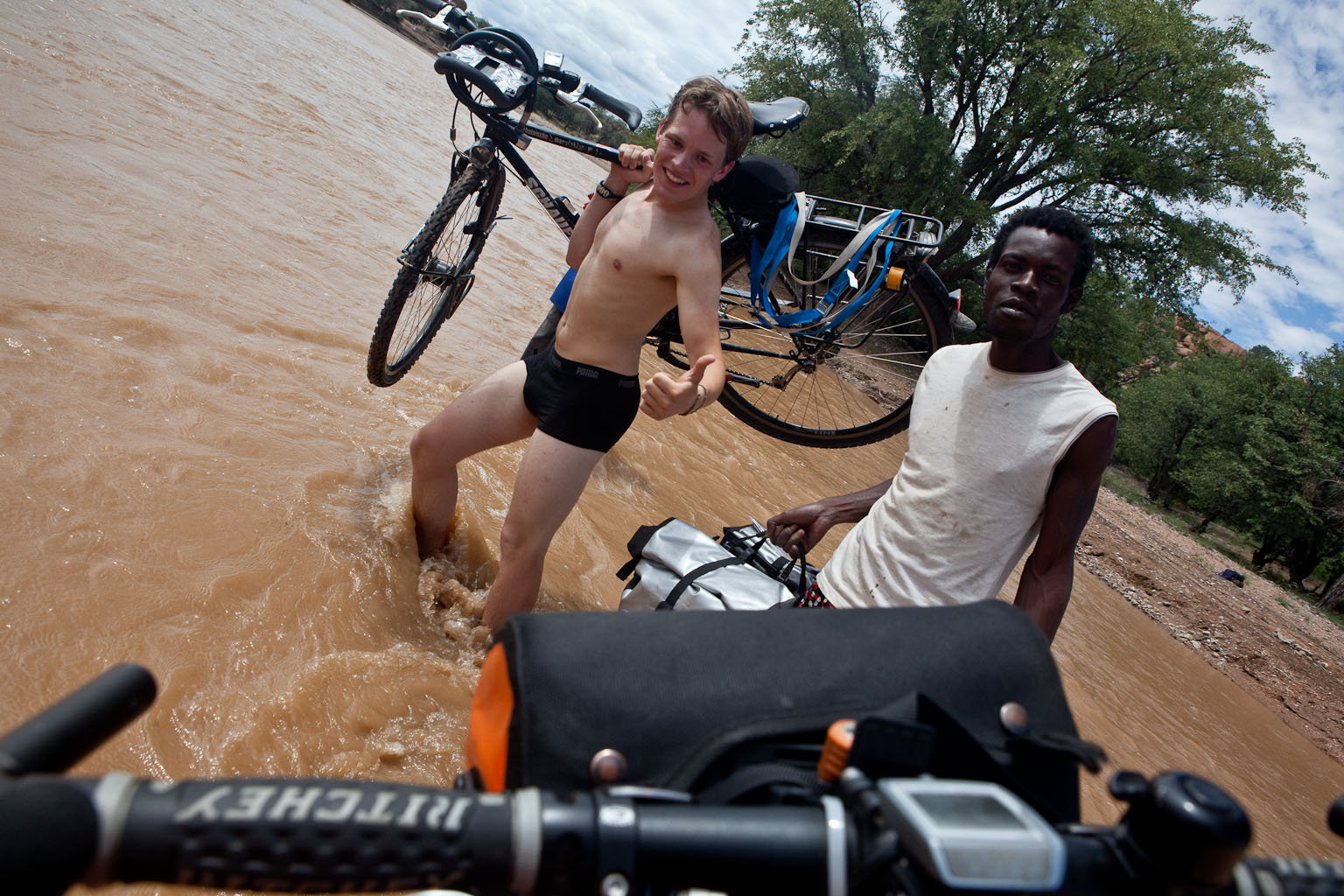
The next day we were on our way up to Twyfelfontein (known for World Heritage Rock Engravings and a petrified forest), some 140km up north west. The road was still gravel and got continually worse (this goes without saying until Khorixas). That day took us through the amazingly lush desert and half desert. We were often told they hadn’t had such amounts of rain in Namibia for years but we (and everybody else) loves it. As said, the desert is green. Covered in grass – it’s hard to imagine this place actually being desert.
The end of the day we encountered our first live rain, that is without any cover (except for rain coats). We were riding up that seemingly endless hill, it grew dark in front of us. It grew dark in the south, in the east, in the west. And with saying dark i mean pitch dark, almost black. Were it grew dark we could see downpours all around us. The gravel road we were travelling on was soaked wet. The bush on both sides was flooded up to your ankles.
The only place it wasn’t raining? Right above us. For some reason we managed to travel in the only corridor it wasn’t raining for some 5kms.
And then our luck stopped.
It was growing dark, we didn’t have a place to sleep yet – only heard about a conservacy office some 5Ks ahead. Now coming to the think about the situation.. no Fabian was not pregnant and there were no angel choires singing. BUT: When we finally arrived the extremly friendly (!) officials allowed us to put up our tent on the porch. A porch with a roof for that matter so it was actually good. And there were donkeys and dogs and zillions of bugs.. but no shepperds. Oh well..
We had a great night there, only interrupted by the donkeys running around in the thunderstorm and around the tent (I’m convinced they actually tried to kill us but didn’t find us in the tent..) and swatting at the bugs.
The following day took us finally to Twyfelfontein. This is particularly interesting because we expected Twyfelfontein to have a shop. We were told so and well it did have a shop. So leaving Uis the day before we had bought supplies for two days although we only needed 1.5 days to Twyfelfontein where we would resupply.
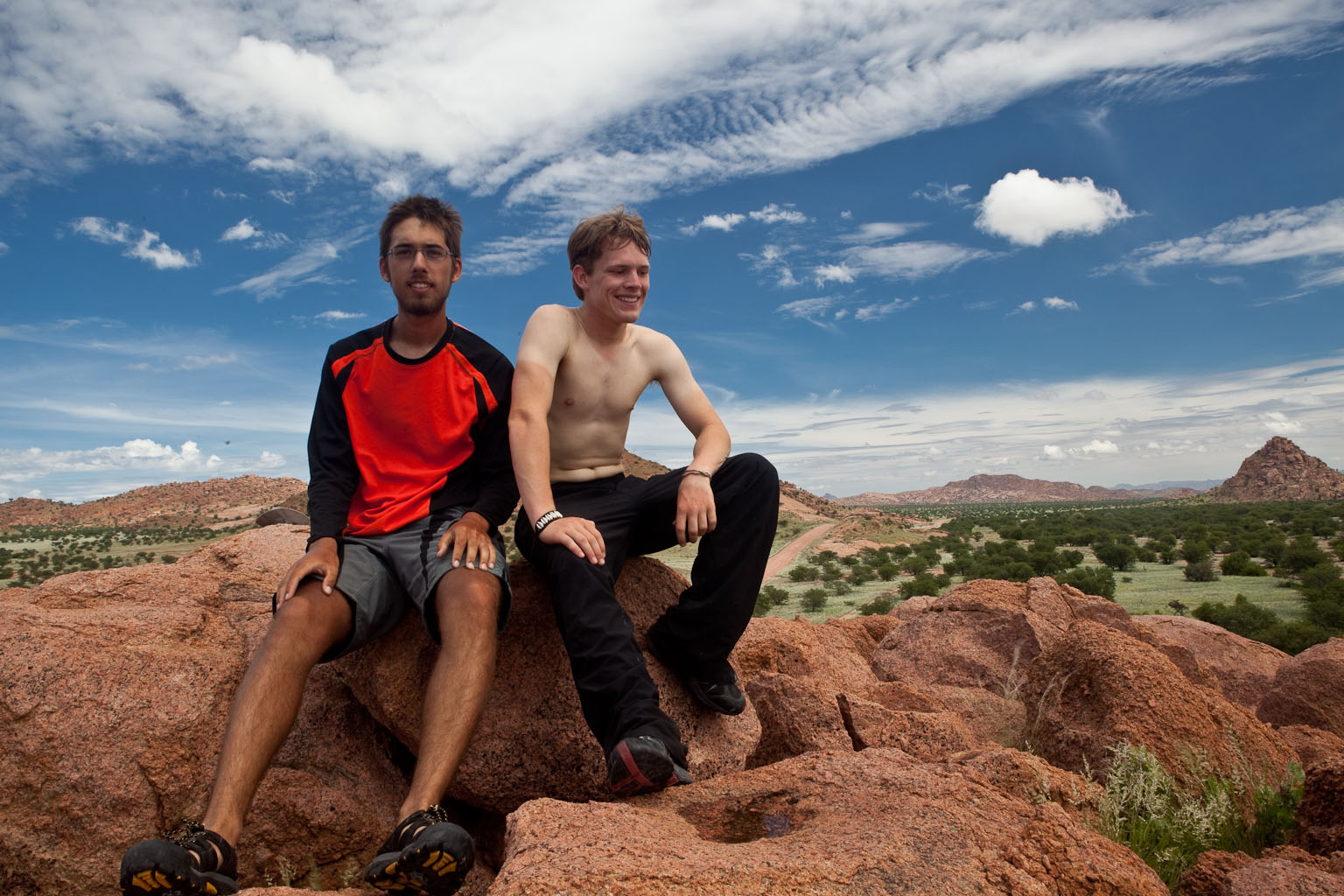
So we wanted to resupply in Twyfelfontein. After crossing the last river we reached the camping ground we wanted to use as basecamp for expeditions to the famous rock engravings, petrified forest and so on. They wouldn’t offer prepared food there. Then we rode 6km on sand (we were exhausted by then) to the Lodge. They wouldn’t let us put up our tent there and wouldn’t sell food. We picked up a ride on the most rundown truck i’ve ever seen to the local workshop and village. They wouldn’t let us put up our tent since it’s conservatory area and you’re only allowed to camp at designated camping grounds.
So another 6km on the sandy road back to the expensive camping ground. We checked in, fatalistic and in bad mood, so fed up we didn’t give a damn about the rock engravings anymore (and we had seen some of them at the lodge anyway). And then.. we made our way to the shop to buy dinner.
That said, we arrived at the shop. I will now list their entire inventory:
Canned Fish
Canned Jam
Canned Fruit
Canned Chakalaka
Four Potatoes
Several bottles of Booze
That’s it. They wouldn’t sell us the potatoes so we bought two cans of Chakalaka, two cans of Fruit and two cans of jam (assuming it was different fruit). Cost: 10 Euros / 100 N$ / 14USD
And it didn’t get us saturated! En bref: We ran out of food. Or rather out of basics. We had two cans of jam remaining, two cans of Chakalaka, a little cheese, some sausage. We would have survived to Khorixas but it messes with morale. We left Twyfelfontein at six o’clock the next morning, waited for enough light to cross the river and never thought about the goddamn rock engravings again.
Seriously. If you’re travelling by bicycle, know it’s some 100km to the next shop (on gravel road) and you’ve got nothing reasonable to eat you don’t start thinking about world heritage. Your entire mind will be focussed on gathering enough energy to get you through the day.
20km outside of Twyfelfontein (the place is amazingly beautiful but it became a synonym for bad roads, high prices and NO FOOD) we found a shop. At the t-junction to the road which runs from Torras Bay to Khorixas there was, totally unexpected, a shop. And best of all: It sold rice and cookies and coke and everything we’ve been looking for (except for bread) and thus lifted our spirits.
We thoroughly needed that to because the road ahead was about to be the worst I’ve experienced on the whole trip so far. Either we had strong front wind, the road was so rough over it’s entire width you could only go on walking speed or it was so sandy you couldn’t go faster anyway. That day was all together really messing with my head.
We did reach the petrified forest and it was amazing but we were mainly focussed on reaching Khorixas, buying food, reaching tarred road. The day continued, everything got even worse (as far as possible) but then, around 4 p.m. our luck finally changed for the best.
We were about to cross that river, standing there unsure whether we should unpack the bikes or just push them through, when that truck stopped. They were moving furniture from somewhere to Otjiwarongo and strapped to the cargo area was a leather couch. And well.. they offered us a ride across the river.
We asked them if they would take us to Khorixas and thus got a 25km lift on a leather couch through the pouring rain in Namibia, bikes at our feet. It was amazing. Not like I would have ever imagined African rides. I did imagine clinging to the cargo platforms in shere terror. But I never expected to sit on a leather couch. And then we arrived – finally – at Khorixas! It was amazing. We decided to stay there for one rest day, had several nice talks with guests and locals. And I for my part an “Erdinger Weissbier”! That did it. The day was saved.
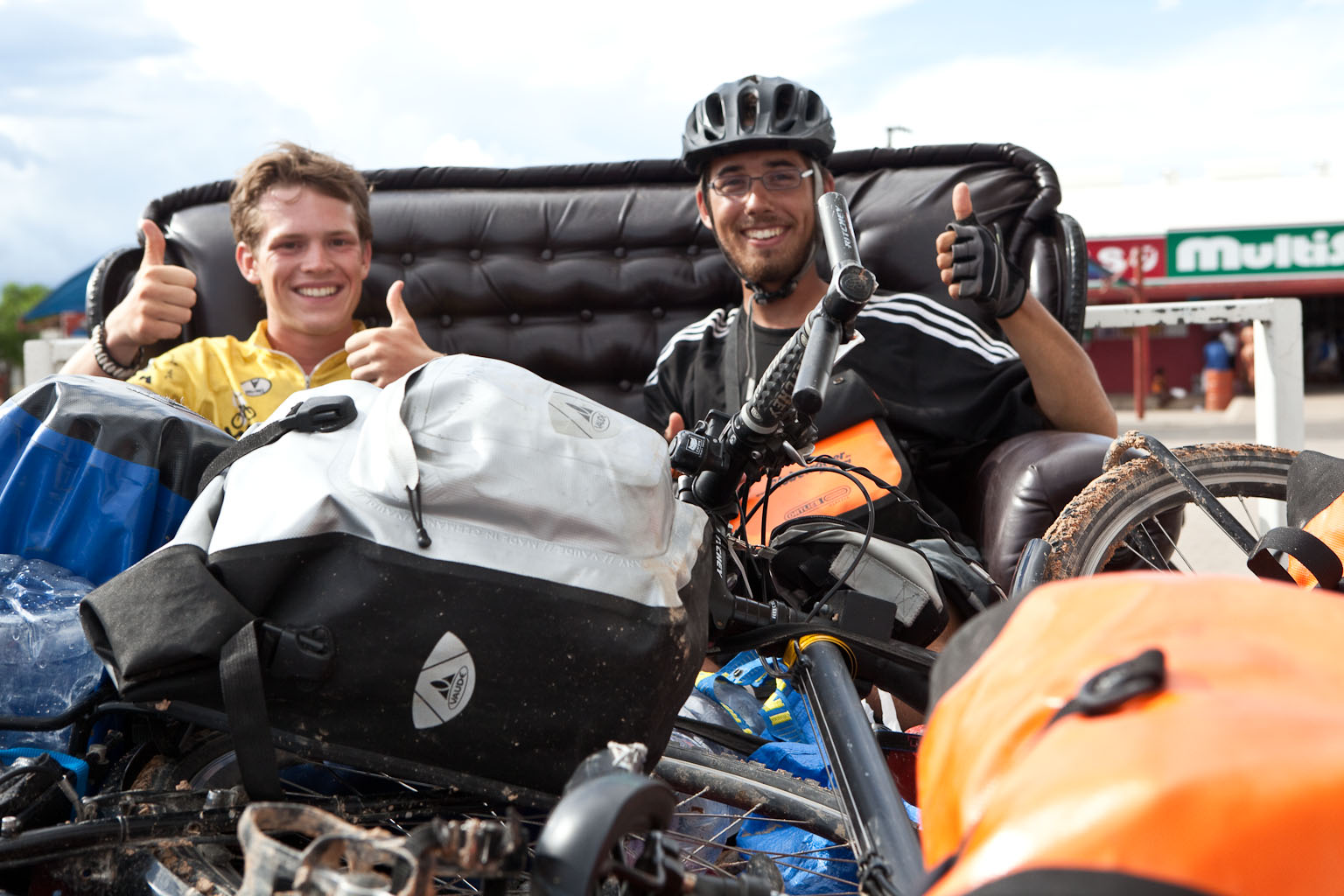
Now I don’t always want to write about negative encounters and I’ve got in mind to publish an article showing all the people that helped us, describing when and where and just saying thank you. But this one I am going to describe now is remarkable for me as a German and in the end turned to be nice too.
Just note that we have at least as many positive conversations and encounters as negative ones and people in general tend to be very friendly around here.
This one for that matter isn’t even about locals. It’s about tourists. German tourists.
The second day at that camping ground/lodge a german bus party arrived. I hadn’t ever wasted a thought on german bus partys being in Namibia and I was struck by shock when I saw that bus arriving, vomiting out the tourists in trekking sandals… wearing socks! No kidding! They were actually wearing socks, light cargo clothing and started taking pictures of the lodge. That was while the sun was still shining and for that matter: That day there was a blackout in Khorixas, so there was no artificial lighting, no water running, no cooking, no internet and so on and so on.
Now as typical for german tourists they would start complaining. Why there is no food prepared for them although the lodge knew they would arrive at 7p.m., why there is no water, no air conditioning, etc. etc. We sat at one of the tables next to the pool (!) writing our travel diaries. For some comic reason we had just been writing about luxury and the way you appreciate it while cycling when those tourists arrived. We had a good laugh at the situation.
An hour later we were sitting at the same table, headlamp on because it was getting dark, eating dinner. Eventually that elderly german bus party couple joined us and started lamenting about the horrors of travelling in Namibia for 30 minutes straight. For some reason I couldn’t stop grinning but eventually it did get annoying. Fabian got up, told him he was fed up with all his complaining and left the table.
I then took the chance to try turn his mind. It’s easy to complain if you spend a lot of money on your holidays. But I guess you can’t justify yourself anymore if somebody, 40 years younger than you, tells you how great life is. How things get tough if you hadn’t had a shower for four days, are stuck without water in the desert and are struggling in the burning heat (that with the water might have been a little exaggerated but it did it’s part). We kept all discussing this for a while, him picking out new complaints and I would always find a) a situation in which it had been worse for us and b) explained how we survived it by shere optimism. Believe it or not, that guy apologized later that evening for all his complaining and seemed to have though a little more about where he was and what privilege it is to be there.
Now what I learned from this was two things: Firstly, I have a new Hobby. Convincing frustrated tourists that they are damn privileged to be there and should look on the bright side of life is great fun. Especially if you’re a cyclist and your argumentation has so far proven to be undisprovable.
Secondly I have become a genuine optimist within three months of cycling here. I used to make fun of my mother for being one of those “hardcore optimists” always trying to find the bright side. Down here you wouldn’t do a 100km without a good portion of optimism and well.. That’s what happened. I would never have admitted it two years ago. But I am a real optimist now. If I start being sad, I stop being sad and be awesome instead! (Barney Stinson)
Okay last thing: After Khorixas we did some 130km by front wind to Outjo, thus setting a new personal record. From there it was 72km to Otjiwarongo where we are now. At the border we met (I think we mentioned that) Ernst and Hildegard Frauscher. They helped us finding our way around and gave us their buisenesscards, if we ever come to Otji or otherwise need help we should call them. Now at that time we never intended to go there but things changed and now we ended up visiting them here. They are great!
We are/were staying at there place near the “center” of the town. We have real beds, a shower with shampoo and fresh towels (in my case that’s the first time in 25 days my hair got in touch with “hair soap”), we got our laundry done, internet and two warm meals a day. If we didn’t have a date in Maun on April 16 I would never leave here again!
Now there’s more to be said about Otji and what we saw/experienced here but I’ll write that in another report, another time. Just as a cliff hanger: We got business cards sponsored by the owners of Studio 5, a gay couple that is so unique we could write an entire report only on those two. We learned a lot about local history, society and racism. The latter of the three is a very interesting topic in these parts because it is omnipresent (or appears to me so) and it’s “lived” in a totally different way than in Germany. I intend (sorry for all the promises, but I WILL write them eventually) to write one Post on the observations on that topic as soon as I’ve collected enough… experience with it. I don’t want to write hastily on this so I guess it will have to wait a while. That said, it’s very interesting and to me extremly irritating.
Now, the last words: Our plans for the coming days. We’re going to head north to Rundu at the Kavango river from where we will turn east into Caprivi District. We will cross the border to Botsuana at Mahango National Park, go south again past the Okavango Delta to Maun, where we will meet the Tour d’Afrique and upload another text (at the latest). That’s some 900km, we’ve got 14 days left, starting tomorrow. I guess we can do it.
Cheers,
Tim
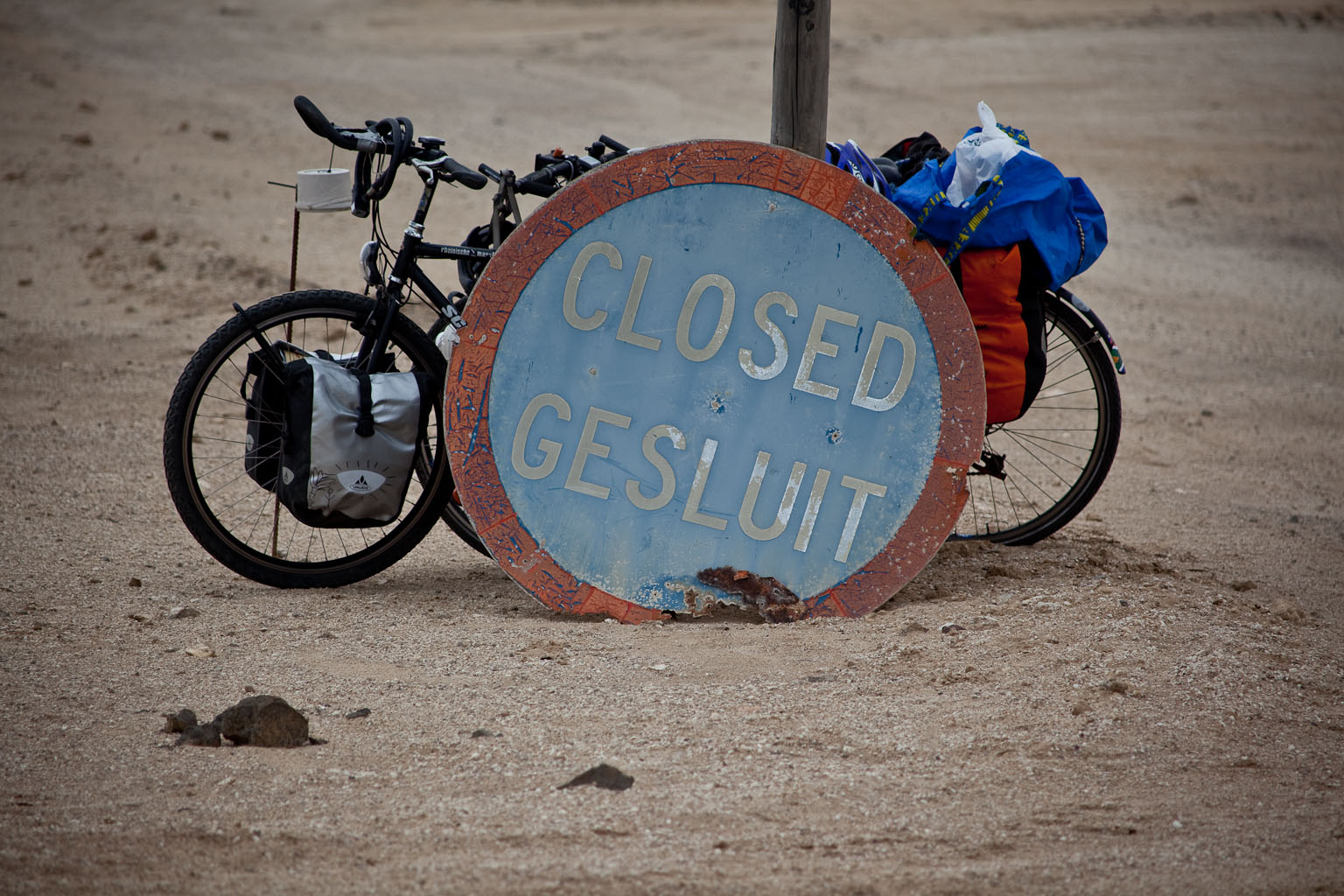
schoene bilder =)
Kann Edda nur zustimmen. Ganz toll. Hoffe Ihr kommt gut weiter. Auch an Edda viele Grüße nach Brasilien. Wie geht’s Dir da?
Ja, genau, ich habe mir eines davon als Bildschirmhintergrund eingerichtet. Nächste Woche, wenn ich wieder mit Oma telefoniere, werde ich ihr zeigen, wie sie das auch tun kann.
Hey ihr 2. Schön wieder von euch gehört zu haben! Weiterhin viel Spaß! Schöne Berichte und schöne Fotos.
Hallo, ihr beiden Radabenteurer!
Am 31.3.2011 stand in den Aachener Nachrichten und in der Aachener Zeitung der Artikel von Daniel Gerhards, den er über euch in Kapstadt geschrieben hat. Anbei die Online-Version – leider ohne das tolle große Foto von euch und ohne den Spendenaufruf, den es in den Zeitungen gab. Es sind übrigens bis Ende März 2400 Euro bei Ärzte ohne Grenzen eingegangen!
Weiterhin eine tolle Fahrt und bleibt gesund!
Einmal im Sattel von Kapstadt nach Kairo
Von Daniel Gerhards 30.03.2011, 17:30
Herzogenrath/Kapstadt. Es ist schon ein recht ungewöhnlicher Tag für Kapstadt. Dichter Nebel hängt über dem Hafenbecken an der Waterfront der südafrikanischen Metropole. Dass dieser Tag zudem etwas kühler ist als üblich, macht Fabian Nawrath und Tim Starck allerdings gar nichts aus. Denn schließlich kamen sie nicht als Touristen an das Kap.
Die beiden wollen nicht bloß Sonne tanken – sie starten von Afrikas Südspitze in das wohl größte Abenteuer ihres Lebens. Die beiden wollen mit dem Rad quer durch Afrika bis nach Kairo fahren!
Gewaltige Strecke
12.000 Kilometer durch zehn afrikanische Staaten – es ist schon eine gewaltige Strecke, die die beiden vor sich haben. Fabian Nawrath aus Kohlscheid studiert Kommunikationsdesign an der FH Aachen.
Über ein Internetforum erfuhr der 21-Jährige von Tim Starcks Plan, einmal quer über den Kontinent zu radeln. «Da war das Internet schon sehr hilfreich. Es gibt ja nicht viele Gleichaltrige mit demselben Traum», sagt Fabian Nawrath.
Für Tim Starck geht nun ein «jahrelang gehegter und gepflegter Traum» in Erfüllung. Der 19-Jährige aus Konstanz hat gerade seinen Zivildienst hinter sich gebracht. Die kommenden sieben Monate wird er mit Fabian Nawrath auf Afrikas Straßen verbringen.
Ein anderes Verkehrsmittel kam für die beiden bei ihrer Durchquerung des Kontinents nicht in Frage. «Das Fahrrad ist langsam genug, um mit den Menschen in Kontakt zu kommen. Und trotzdem sieht man am Ende des Tages, dass man ein gutes Stück vorangekommen ist», erklärt Nawarath. Der Kontakt zu den Bewohnern der unterschiedlichen Regionen des Kontinents ist den beiden sehr wichtig. Das gehört zu diesem einmaligen Erlebnis.
Gespräche mit Einheimischen werden sich für die Radabenteurer zwangsläufig ergeben. Denn auf der Suche nach einer Unterkunft oder zumindest einem Stück Wiese für ihr Zelt sind sie nun mal auf Hilfe angewiesen. Dabei können sie sich nicht bloß auf die Straßenkarte und ihren Orientierungssinn verlassen.
Platz für das Nötigste
Das Zelt ist schon auf Tim Starcks Gepäckträger festgezurrt. Daneben haben beide vier Taschen an ihrem Rad. Nicht viel. Doch bieten sie zumindest etwas Platz für etwas Kleidung, Essen und die wichtigsten Werkzeuge: Schraubenschlüssel, Flickzeug und Ersatzschläuche haben sie dabei. «Damit kann man schon relativ viel reparieren», sagt Fabian Nawrath.
Und das wichtigste Werkzeug hat Tim Starck auch in seiner Tasche: Panzertape. Das extrastarke Klebeband kann abgebrochene Teile für einige Kilometer fixieren. Das kann im Notfall immerhin bis zur nächsten Ortschaft reichen…
Zu viel Zeit dürfen die beiden allerdings nicht in einer Werkstatt verbringen. Denn sie haben ein ehrgeiziges Programm vor sich. «Theoretisch müssen wir 90 Kilometer pro Tag fahren», rechnet Starck vor. «Auf europäischen Straßen ist das kein Problem. Ob wir das in Afrika schaffen, werden wir sehen.» Sieben Monate haben die beiden Zeit, um Kairo zu erreichen. Dann geht es für Nawrath zurück in die Uni und Starck beginnt seine Ausbildung.
Ihre Route mitten durch den afrikanischen Kontinent wird die beiden durch atemberaubende Landschaften führen. Starck: «Auf dem Weg liegen allerdings auch politisch unsichere Staaten.» So wollen sie unter anderem durch den Sudan fahren. Angst haben die jungen Radfahrer dennoch nicht. «Wir wissen schon, dass man vorsichtig sein muss. Man muss sensibel sein und auf seine Umgebung achten. Aber ich denke, dass die größte Gefahr von den Trucks ausgeht», sagt Fabian Nawrath. Denn auf den meisten afrikanischen Straßen gilt: Der Schnellere hat Vorfahrt!
Nur Freude
Doch an die Unwegsamkeiten wollen die beiden vorerst nicht denken. «Im Moment spüren wir nur Vorfreude, nichts als Vorfreude.» Schließlich wartet das große Abenteuer. Und dann schwingen sie sich auf ihre Räder – und fahren einfach los…
http://www.an-online.de/sixcms/detail.php?template=an_detail&id=1635543&_wo=Lokales:Nordkreis
Nettes Package haha.
*bissl wiener humor runteschick* :O